Andrew Borntreger of Badmovies.org
fame, in his review for A
Boy and His Dog (also linked below), puts forth that "You
have to respect any film that starts off with a nuclear war."
I'm not here to disclaim that (though I doubt Andrew has ever
seen In the Year 2889), but there is no denying that for
decades, such movies played on our most singular creeping fear:
that someone would piss somebody else off enough to push The Button.
There were opportunistic movies like The Day The World Ended
that played off that fear in the late 50's, and the temperature
got turned up a notch in the early 60's when the Cuban Missile
Crisis added a new phrase to the geopolitical lexicon: nuclear
brinkmanship. This was the atmosphere that brought us Dr.
Strangelove and Fail Safe, two remarkably similar yet
entirely different movies.
By the 70's, things had settled down a bit, but
only a bit; one can live in terror only so long before the terror
sublimates to a sort of doomed fatalism. We all accepted that
nuclear war was a possibility, perhaps inevitable; so, before
the phrase was even invented, we all partied like it was 1999.
There. I have now officially blamed nuclear politics for the creation
of Disco.
When most people mention Damnation Alley,
it is to reference one of two things: the opening segment, often
sited as "one of the most chilling representations of nuclear
war", or the totally boss RV our heroes use to tool around
in. More on that later. We're getting ahead of ourselves.
We begin at an Air Force missile base in the middle
of the Mojave Desert, and meet the two guys we're going to be
hanging with for the next hour and a half: Denton (George Peppard),
a fairly by-the-book military type, and Tanner (Jan Michael Vincent),
who is, shall we say, somewhat less than by-the-book. They pass
through various security points, at one point checking in with
another familiar face, Keegan (Paul Winfield), the base artist.
As Keegan issues them firearms, Denton asks him what he would
charge for an oil painting; he'd like his wife to pose when she
gets back from Chicago. As the movie we are watching is called
Damnation Alley, wagering that Chicago is not going to
survive the next ten minutes is a sucker bet.
Denton and Tanner, it turns out, are the guys who
are in charge of the two keys that must be turned in unison to
initiate a 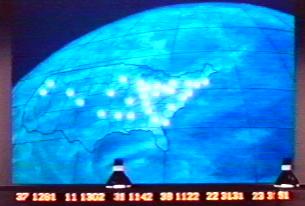 nuclear
launch. It also turns out that Denton doesn't like Tanner and
is requesting the younger man be rotated to another duty. This
all becomes moot when the base's Big Board begins registering
multiple missile tracks coming from a certain evil empire, and
Denton and Tanner wind up using their keys, launching the missile
stock footage. Their work done, they slip into the command center
and watch as the oncoming tracks continue their steady trail toward
the map of America - interceptors only take out 40% of the attacking
force. An unemotional voice over the intercom tells us which cities
get hit, a slow intoning of doom, which cuts to the mandatory
footage of mushroom clouds.
nuclear
launch. It also turns out that Denton doesn't like Tanner and
is requesting the younger man be rotated to another duty. This
all becomes moot when the base's Big Board begins registering
multiple missile tracks coming from a certain evil empire, and
Denton and Tanner wind up using their keys, launching the missile
stock footage. Their work done, they slip into the command center
and watch as the oncoming tracks continue their steady trail toward
the map of America - interceptors only take out 40% of the attacking
force. An unemotional voice over the intercom tells us which cities
get hit, a slow intoning of doom, which cuts to the mandatory
footage of mushroom clouds.
I don't know about chilling, but the sequence
is what we used to call in the advertising trade impactful.
The viewer goes from hearing the name of either his hometown or
a town nearby and is swept immediately to a Technicolor (and "Sound
360") representation of what would be happening. I noted
somewhat smugly that the missiles never seemed to reach Texas,
especially the Houston area - but that's okay, we were nuked anyway,
and by our own country, no less, in Independence Day.
Anyway, after that, titles inform us that the combined
nuclear explosions tilted the Earth off its axis, with the result
that even more people died, the sky has turned into a Pink Floyd
Laser Light Show, and the whole world now looks like Utah. The
base, secure in its secluded, hardened bunker, survived. The men
try to hold to some aimless semblance of normal life. Denton continues
to work away in the motor bay, building something, with
the assistance of Airman Perry (Kip Niven).
Keegan and Tanner, however, have retired themselves
from the Air Force. Keegan spends his time painting tropical 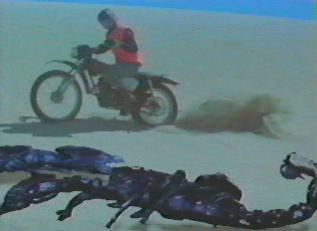 landscapes
on his bunker and keeping watch on the desert. Tanner keeps taking
off on his motorcycle, at one time going as far as Phoenix in
his search for survivors. On Tanner's latest return, we find out
what Keegan's watching for: the desert is inhabited by giant mutant
scorpions (Enjoy the giant mutant scorpions now, while you can;
you shall never see them again in this movie).
landscapes
on his bunker and keeping watch on the desert. Tanner keeps taking
off on his motorcycle, at one time going as far as Phoenix in
his search for survivors. On Tanner's latest return, we find out
what Keegan's watching for: the desert is inhabited by giant mutant
scorpions (Enjoy the giant mutant scorpions now, while you can;
you shall never see them again in this movie).
Things inside the base have gotten somewhat lax,
though, and one Airman goes to sleep while smoking in bed... next
to a mass of pipes bearing a sign that reads, "WARNING: Flammable
Gas!" The resulting explosion is pretty impressive.
The only survivors are the two nonconformists, Keegan
and Tanner, and Denton and Perry, who were in the motor pool.
Denton wheels out the project that has been occupying him and
Perry: they've been completing the two prototype Landmasters,
huge all-terrain vehicles with novel three-wheel arrangements,
all sorts of high-tech stuff and missile launchers. It is Denton's
intention to take the Landmasters all the way to Albany, New York,
the source of the only continuous radio signal heard since The
War (and it is at this point that we find out The War was two
years ago).
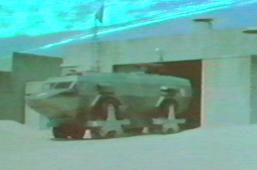 So
our heroes set out, and run almost immediately into a freakish
storm seemingly composed of many small twisters. Tanner decides
to bully his way through the storm while the rather more regulation-minded
Perry digs in his Landmaster. This was a poor career choice for
Perry, as the storm picks up his stationary Landmaster and hurls
it willy-nilly, while Tanner and Denton wind up safe and sound
on he other side of the storm. Perry's neck is broken; Keegan
makes it out with only a lacerated leg (one of the few times the
token black character is not the first to die).
So
our heroes set out, and run almost immediately into a freakish
storm seemingly composed of many small twisters. Tanner decides
to bully his way through the storm while the rather more regulation-minded
Perry digs in his Landmaster. This was a poor career choice for
Perry, as the storm picks up his stationary Landmaster and hurls
it willy-nilly, while Tanner and Denton wind up safe and sound
on he other side of the storm. Perry's neck is broken; Keegan
makes it out with only a lacerated leg (one of the few times the
token black character is not the first to die).
The next stop for our trio is Las Vegas, where not
only is the Circus Circus still standing, but it still has power.
"Boy, nothin' changes," says Tanner. "Bomb or no
bomb, the lights never go out in Vegas!" Keegan and Tanner
set to playing the slots with wild abandon; even the staid Denton
finds himself grinning and pulling the levers of one-armed bandits.
This makes a lot of noise,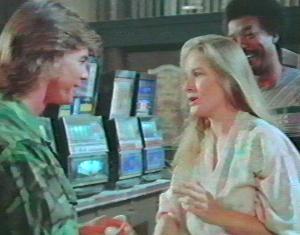 and the noise rouses Janice (Dominique Sanda) - the Last Woman
Alive In Vegas. A singer/songwriter at the hotel, she was - ahem-
performing for the manager in the fallout shelter when the bombs
hit. She never does explain how the power is still on, however.
and the noise rouses Janice (Dominique Sanda) - the Last Woman
Alive In Vegas. A singer/songwriter at the hotel, she was - ahem-
performing for the manager in the fallout shelter when the bombs
hit. She never does explain how the power is still on, however.
So now our four heroes trek onto Salt Lake City,
which may seem like a roundabout route to Albany, but Denton is
navigating what he calls "Damnation Alley", a path that
skirts the areas of highest radiation. In any case: Salt Lake
City, where they stop to get some gasoline. Tanner and Janice
take off on his bike to scrounge for more supplies. Keegan, examining
the many automobile hulks lying about, remarks on the strangely
clean bones within the cars. "It's been a couple of years,"
says Denton. "Yeah," mutters Keegan, "but the windows
are closed." They start to pumping gas after Keegan
attaches the hose to the underground tank, and Keegan notices
tons of large cockroaches coming up from the hatch. These roaches
resist stomping and they bite. Hard. Suddenly
Keegan finds himself pursued by a raft of roaches, and forgetting
the skeletons in the sealed cars, hops inside one himself.
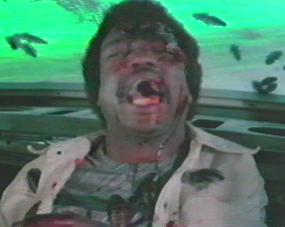 Denton
rolls the Landmaster over to Keegan's makeshift fortress and uses
the standard weapon employed in every crap movie of any note:
the fire extinguisher. Unfortunately, its too late for Keegan,
who has become a roach buffet (I didn't say the token black lasted
the entire movie, did I?). Tanner and Janice, meantime, have been
trapped in a department store by the beastly blattidae,
and are racing up, floor by floor to keep ahead of them. Thus
Denton's cry over the radio of "This whole town is infested
with killer cockroaches, repeat, KILLER COCKROACHES!"
- surely the most quotable line in the movie - comes as no surprise
to them. Tanner has to pull an Evel Kneivel through a top story
window to a parking garage next door to escape the carnivorous
tide, and Denton uses the Landmaster's mortars to blast through
the garage's walls to pick them up. Phew. That was close.
Denton
rolls the Landmaster over to Keegan's makeshift fortress and uses
the standard weapon employed in every crap movie of any note:
the fire extinguisher. Unfortunately, its too late for Keegan,
who has become a roach buffet (I didn't say the token black lasted
the entire movie, did I?). Tanner and Janice, meantime, have been
trapped in a department store by the beastly blattidae,
and are racing up, floor by floor to keep ahead of them. Thus
Denton's cry over the radio of "This whole town is infested
with killer cockroaches, repeat, KILLER COCKROACHES!"
- surely the most quotable line in the movie - comes as no surprise
to them. Tanner has to pull an Evel Kneivel through a top story
window to a parking garage next door to escape the carnivorous
tide, and Denton uses the Landmaster's mortars to blast through
the garage's walls to pick them up. Phew. That was close.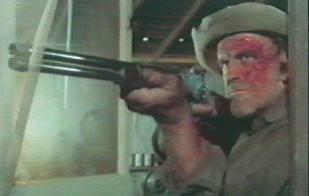
Next stop: a mysterious shack in the middle of nowhere,
to pick up a recently orphaned boy named Billy (Jackie Earle Haley),
who, true to his Bad News Bears background, is deadly with
a thrown rock. (There is a bit somewhere in here that I am missing,
something about the Landmaster's nuclear family structure, but
frankly, I don't think it's worth the trouble) Then our next stop
along scenic Damnation Alley is a gas station, similarly in the
middle of nowhere (the nuclear war apparently extended the boundaries
of Nowhere, so its middle is likewise huge). There our heroes
are surprised by a rifle-toting pack of mutants.
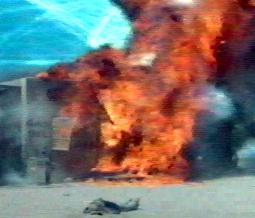 Well,
not actually mutants, more like mountain men bleeding from multiple
radiation sores (it being Nowhere, there are no actual mountains,
but there you are), looking for all the world like they just straggled
off the set of Deliverance. It is only thanks to Billy's
deadly rock-throwing abilities and his skill at prevarication
that Tanner manages to blow out the tiny brains of two of the
brigands. Then, as Janice escapes from the gas station, Denton
takes care of the last of the mountain men with two rockets from
the Landmaster's missile launchers, one of the better examples
of overkill I've seen in a while.
Well,
not actually mutants, more like mountain men bleeding from multiple
radiation sores (it being Nowhere, there are no actual mountains,
but there you are), looking for all the world like they just straggled
off the set of Deliverance. It is only thanks to Billy's
deadly rock-throwing abilities and his skill at prevarication
that Tanner manages to blow out the tiny brains of two of the
brigands. Then, as Janice escapes from the gas station, Denton
takes care of the last of the mountain men with two rockets from
the Landmaster's missile launchers, one of the better examples
of overkill I've seen in a while.
By this time the Landmaster's transmission is starting
to make loud clanking sounds, but no worry - the great beast was
designed to use truck parts! So a quick detour to the wrecking
yards of Detroit is called for. Now why people haven't chosen
to settle in Detroit is beyond me - the junkyard looks like it
hasn't been touched by 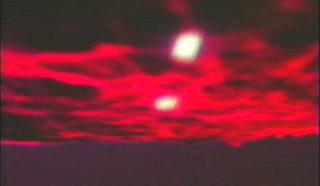 the
nuclear exchange; even the salvaged hulks of cars look quite clean
- no layers of dirt as on the other cars we've seen. Denton finds
a likely prospect and goes to work with a wrench. Billy goes out
exploring, looking for a sidecar for the motorcycle, not noticing
that the sky has turned an electric red and is starting to do
a fairly good imitation of the last twenty minutes of 2001.
It's up to Tanner to fly through the aisles of shifting metal
in heightened winds to bring the youngest member of our crew back...
and just in time, as not only high winds but a colossal tsunami
engulfs the junkyard. It's the first water we've seen in the entire
movie; I guess the same absence of nukage that preserved the wrecking
yard also left the Great Lakes untouched.
the
nuclear exchange; even the salvaged hulks of cars look quite clean
- no layers of dirt as on the other cars we've seen. Denton finds
a likely prospect and goes to work with a wrench. Billy goes out
exploring, looking for a sidecar for the motorcycle, not noticing
that the sky has turned an electric red and is starting to do
a fairly good imitation of the last twenty minutes of 2001.
It's up to Tanner to fly through the aisles of shifting metal
in heightened winds to bring the youngest member of our crew back...
and just in time, as not only high winds but a colossal tsunami
engulfs the junkyard. It's the first water we've seen in the entire
movie; I guess the same absence of nukage that preserved the wrecking
yard also left the Great Lakes untouched.
Luckily, the Landmaster was designed to float,
"Even," as Denton assures his crew, "if it's half-full of water."
He and Tanner force open the top hatch to discover that the sky
has miraculously turned blue! Yes, that whole welter of special
effects was the Earth shifting back to its normal axis! Just to
prove that point, when the Landmaster manages to churn itself
to land, it no longer looks like Utah; no, there are trees and
grass! Looks remarkably like California, in fact. Hmmmm...
The two men set to working on their respective vehicles
by lakeside, when a sputter comes over their radio: it's a live
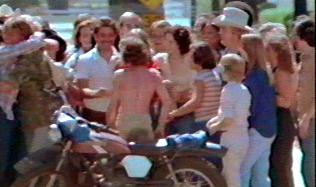 broadcast
from Albany! They're not too far away! Tanner and Billy hop on
the bike and roar off to meet these new people, much to Denton's
ire. "We're sending an emissary," he ruefully says into
the microphone. "Please do not think him representative of
the rest of us." Meanwhile, down the road, Tanner and Billy
meet the survivors as about fifty people come out to meet them
in an idyllic, farm-like setting. And I could not help but notice
that each and every one of them was white. Make of that what you
will. The end.
broadcast
from Albany! They're not too far away! Tanner and Billy hop on
the bike and roar off to meet these new people, much to Denton's
ire. "We're sending an emissary," he ruefully says into
the microphone. "Please do not think him representative of
the rest of us." Meanwhile, down the road, Tanner and Billy
meet the survivors as about fifty people come out to meet them
in an idyllic, farm-like setting. And I could not help but notice
that each and every one of them was white. Make of that what you
will. The end.
I probably don't need to tell you that Damnation
Alley was based on a novel by Roger Zelazny, which was itself
loosely based on an event in American history, the same one which
was the basis for the recent animated movie Balto: a diphtheria
epidemic in a remote northern settlement prompted a group of men
and dogsleds to race through impossible weather and terrain to
get drugs to the stricken settlement. In the novel, a load of
serum needs to be taken through Damnation Alley to Boston (if
I'm recalling correctly), and the only man for the job is motorcycle
desperado Hell Tanner, who pilots the Landmaster alone.
This might have made a compelling movie, but the
changes wrought for this movie version are not onerous. Starting
with the War to gain audience attention is a good idea; the reason
the Landmasters even exist is reasonable; and expanding the cast
opens up new dynamics. But Damnation Alley the movie fails
to do much with these elements.
For instance, unwritten movie law demands that if
Denton and Tanner do not like each other at the beginning of the
movie, 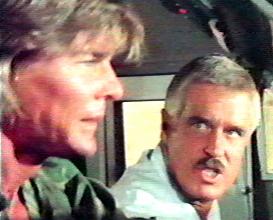 they
must at least have a grudging respect for each other by the end.
There is a reason this device is employed over and again in screenplays,
and that is it's immensely satisfying to the audience - the underlying
moral that if we all work together, we can accomplish great things,
is not lost on us. This is why the buddy film has been with us
so many decades. This expected reconciliation does not happen.
We never see the characters change in any way, manner or form,
or show much in the way of any personal interaction (outside
of grim resolution) after the personable Keegan gets eaten. I
would normally applaud the fact that the sole female character
is not shoehorned into a romantic relationship with either of
the men, but I have to feel that this not due to any desire to
break with cliché's, but simply more bad writing - astounding
in that Lukas Heller is the top-billed writer, and he turned in
fine character work in The Dirty Dozen, Hush Hush Sweet Charlotte
and Whatever Happened to Baby Jane?
they
must at least have a grudging respect for each other by the end.
There is a reason this device is employed over and again in screenplays,
and that is it's immensely satisfying to the audience - the underlying
moral that if we all work together, we can accomplish great things,
is not lost on us. This is why the buddy film has been with us
so many decades. This expected reconciliation does not happen.
We never see the characters change in any way, manner or form,
or show much in the way of any personal interaction (outside
of grim resolution) after the personable Keegan gets eaten. I
would normally applaud the fact that the sole female character
is not shoehorned into a romantic relationship with either of
the men, but I have to feel that this not due to any desire to
break with cliché's, but simply more bad writing - astounding
in that Lukas Heller is the top-billed writer, and he turned in
fine character work in The Dirty Dozen, Hush Hush Sweet Charlotte
and Whatever Happened to Baby Jane?
Too, the movie is episodic in nature. Now, the novel
was also episodic, but Zelazny was a master storyteller, and each
encounter in the Alley served to change Tanner, to open up his
humanity more, until by the end of the novel, with the Landmaster
irretrievably broken, he has the strength of character to walk
the rest of the way, carrying the serum like a pack mule.
The episodes of Damnation Alley are simply
that: episodes, with no real suspense or tension built up; there
is never any real doubt that Tanner and Janice will escape the
killer cockroaches, or that our heroes will whomp up on the hillbillies.
I lay the blame for that on the shoulders of director Jack Smight,
whose body of work consists primarily of television movies. Damnation
Alley, despite its effects, looks and feels like it was shot
for the small screen. For instance: in the scene where the radio
reveals that there are still people alive in Albany, the actors
are blocked so that their backs are to us - we cannot see their
faces at this climactic moment. I will, however, give Smight
this - I bet he brought the film in on time and under budget.
Post-Apocalyptic movies like The Road Warrior
succeeded primarily because they reinvented the Western with
a great deal 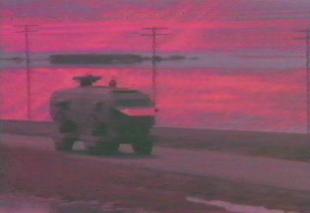 of
panache and a character all their own. Unfortunately, the movie
that Damnation Alley seems to be reinventing is The
Incredible Journey, a 60s family film that followed two dogs
and a cat as they trekked across country to their home. The adventures
they had were similarly non-threatening, and at least you never
expected animals to develop character.
of
panache and a character all their own. Unfortunately, the movie
that Damnation Alley seems to be reinventing is The
Incredible Journey, a 60s family film that followed two dogs
and a cat as they trekked across country to their home. The adventures
they had were similarly non-threatening, and at least you never
expected animals to develop character.
Which leaves us little to look forward to except
the special effects. The effects in Damnation Alley are
pretty good, especially the sky effects, accomplished without
any sort of digital jiggery-pokery. The rest of the money shots,
however, are nothing you haven't already seen in a Bert I. Gordon
movie, and used in the service of a better story, to boot.